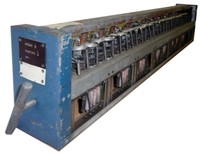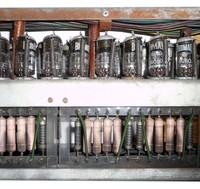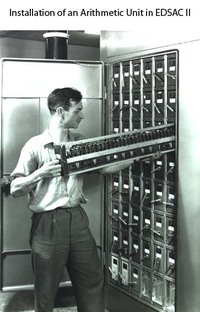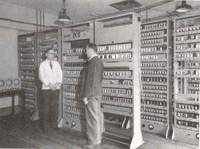EDSAC II Arithmetic Unit
| Home > Browse Our Collection > Computers > EDSAC > EDSAC II Arithmetic Unit |
|
This object in our collection is an arithmetic unit from EDSAC II, marked "EDSAC II - Chassis 1". The arithmetic logic unit/arithmetic-logic unit (ALU) of a computer's CPU (central processing unit) is a part of the execution unit, a core component of all CPUs. ALUs are capable of calculating the results of a wide variety of basic arithmetical computations. In early 1958 EDSAC was replaced by EDSAC II. It was built by the same team as EDSAC I, once again led by Maurice Wilkes. The mercury tubes used in EDSAC I were replaced with a 32-by-32 magnetic core matrix using ferrite rings. EDSAC II once again used five-hole punched paper tape for input and output. The tape reader could read at speeds up to 1,000 rows of holes per second and stop instantly, with the next row in position for reading. EDSAC II was the first computer to have a microprogrammed control unit and a bit slice hardware architecture. Its microprogrammed control unit established beyond doubt the viability of microprogramming as a basis for computer design, despite the fact that vacuum tubes were far from ideal for the purpose. At the mechanical level of organisation, EDSAC 2 was packaged in a bit-sliced manner, with interchangeable plug-in units. This method of packaging was well matched to the vacuum tube technology of the period, and its expected advantages - arising from the replication of units - were fully realised. The first calculations run on the computer were run before it became fully operational, when it was known as EDSAC 1 ½, and concerned the life cycle of a star. Other calculations run on EDSAC 2 included calculations about elliptic curves that led to the Birch and Swinnerton-Dyer conjecture, which later became a Millennium Prize Problem, and is still unsolved as of 2023. In 1963, Frederick Vine and Drummond Matthews used EDSAC 2 to generate a seafloor magnetic anomaly map from data collected in the Indian Ocean by H.M.S. Owen, key evidence that helped support Plate Tectonic theory. EDSAC II continued in use until 1965. In 1964 the Titan computer, which was developed between the Mathematical Laboratory and Ferranti, became operational. The closing down ceremony in 1965 was attended by Prof Maurice Wilkes, John Horton and Andrew McKernan among others. Manufacturer: Cambridge University Mathematical Laboratory Comment on This Page This exhibit has a reference ID of CH11977. Please quote this reference ID in any communication with the Centre for Computing History. |
|
















